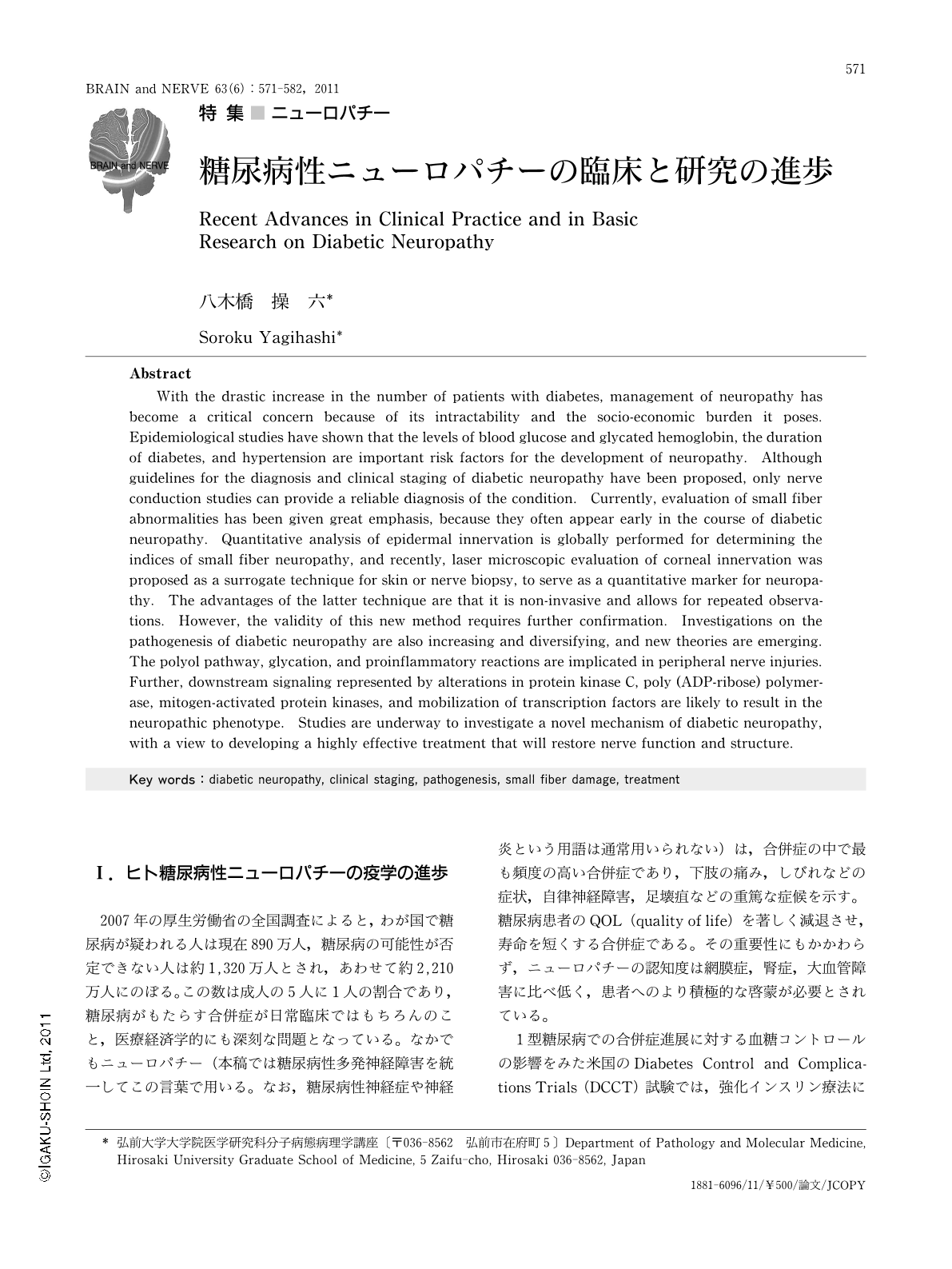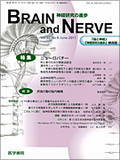Japanese
English
- 有料閲覧
- Abstract 文献概要
- 1ページ目 Look Inside
- 参考文献 Reference
Ⅰ.ヒト糖尿病性ニューロパチーの疫学の進歩
2007年の厚生労働省の全国調査によると,わが国で糖尿病が疑われる人は現在890万人,糖尿病の可能性が否定できない人は約1,320万人とされ,あわせて約2,210万人にのぼる。この数は成人の5人に1人の割合であり,糖尿病がもたらす合併症が日常臨床ではもちろんのこと,医療経済学的にも深刻な問題となっている。なかでもニューロパチー(本稿では糖尿病性多発神経障害を統一してこの言葉で用いる。なお,糖尿病性神経症や神経炎という用語は通常用いられない)は,合併症の中で最も頻度の高い合併症であり,下肢の痛み,しびれなどの症状,自律神経障害,足壊疽などの重篤な症候を示す。糖尿病患者のQOL(quality of life)を著しく減退させ,寿命を短くする合併症である。その重要性にもかかわらず,ニューロパチーの認知度は網膜症,腎症,大血管障害に比べ低く,患者へのより積極的な啓蒙が必要とされている。
1型糖尿病での合併症進展に対する血糖コントロールの影響をみた米国のDiabetes Control and Complications Trials(DCCT)試験では,強化インスリン療法による厳格な血糖コントロールで,通常療法のHbAlc9%におけるニューロパチーの発症率13%に比べ,強化療法のHbAlc7%での発症率は5%となり,発症者数を約60%減少させることができたとしている。さらに顕著なことは,試験終了後の8年間観察で新規ニューロパチー発症率がさらに抑制されたことから,厳格な血糖コントロールの効果が,その終了後も持続する,いわゆる「遺産効果(legacy effect)」あるいは「糖記憶(glucose memory)」として残されることが示され,改めて血糖コントロールの合併症発症に対する重要性が確認されている(Fig.1)1)。血糖コントロールのニューロパチーへの影響は2型糖尿病においても同様で,わが国でのKumamoto studyにおいて強化インスリン療法が神経伝導速度低下や振動覚閾値の改善効果を示すことが証明された2)。一方,英国でのUK Prospective Diabetes Study(UKPDS)では,10年間の経過観察でHbA1c0.9%の低下では網膜症,腎症の減少をみたものの,ニューロパチー,大血管障害への影響はみられなかったとしている3)。ニューロパチー進展の危険因子として,Tesfayeらは,1型糖尿病患者を平均7.5年にわたって経過観察し,糖尿病罹病期間,HbA1c,高血圧,脂質異常(高中性脂肪血症,高リポプロテイン血症),喫煙,高BMI,ミクロアルブミン尿,高von Willebrand因子血症を挙げている4)。このようなデータからみて,高血糖の持続がニューロパチーの発症,進展の中心となっており,その促進因子として,血管障害を伴う病態の意義が示唆される。
Abstract
With the drastic increase in the number of patients with diabetes,management of neuropathy has become a critical concern because of its intractability and the socio-economic burden it poses. Epidemiological studies have shown that the levels of blood glucose and glycated hemoglobin,the duration of diabetes,and hypertension are important risk factors for the development of neuropathy. Although guidelines for the diagnosis and clinical staging of diabetic neuropathy have been proposed,only nerve conduction studies can provide a reliable diagnosis of the condition. Currently,evaluation of small fiber abnormalities has been given great emphasis,because they often appear early in the course of diabetic neuropathy. Quantitative analysis of epidermal innervation is globally performed for determining the indices of small fiber neuropathy,and recently,laser microscopic evaluation of corneal innervation was proposed as a surrogate technique for skin or nerve biopsy,to serve as a quantitative marker for neuropathy. The advantages of the latter technique are that it is non-invasive and allows for repeated observations. However,the validity of this new method requires further confirmation. Investigations on the pathogenesis of diabetic neuropathy are also increasing and diversifying,and new theories are emerging. The polyol pathway,glycation,and proinflammatory reactions are implicated in peripheral nerve injuries. Further,downstream signaling represented by alterations in protein kinase C,poly (ADP-ribose) polymerase,mitogen-activated protein kinases,and mobilization of transcription factors are likely to result in the neuropathic phenotype. Studies are underway to investigate a novel mechanism of diabetic neuropathy,with a view to developing a highly effective treatment that will restore nerve function and structure.

Copyright © 2011, Igaku-Shoin Ltd. All rights reserved.


